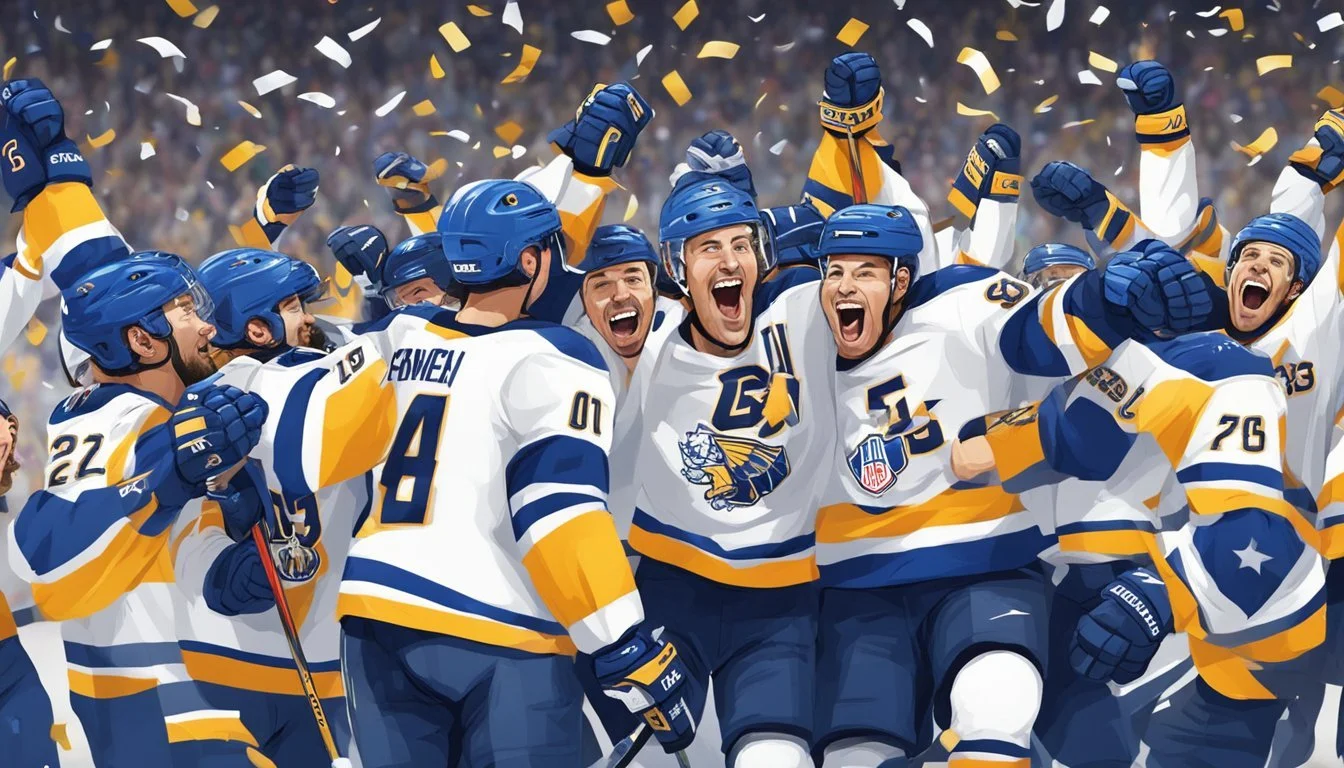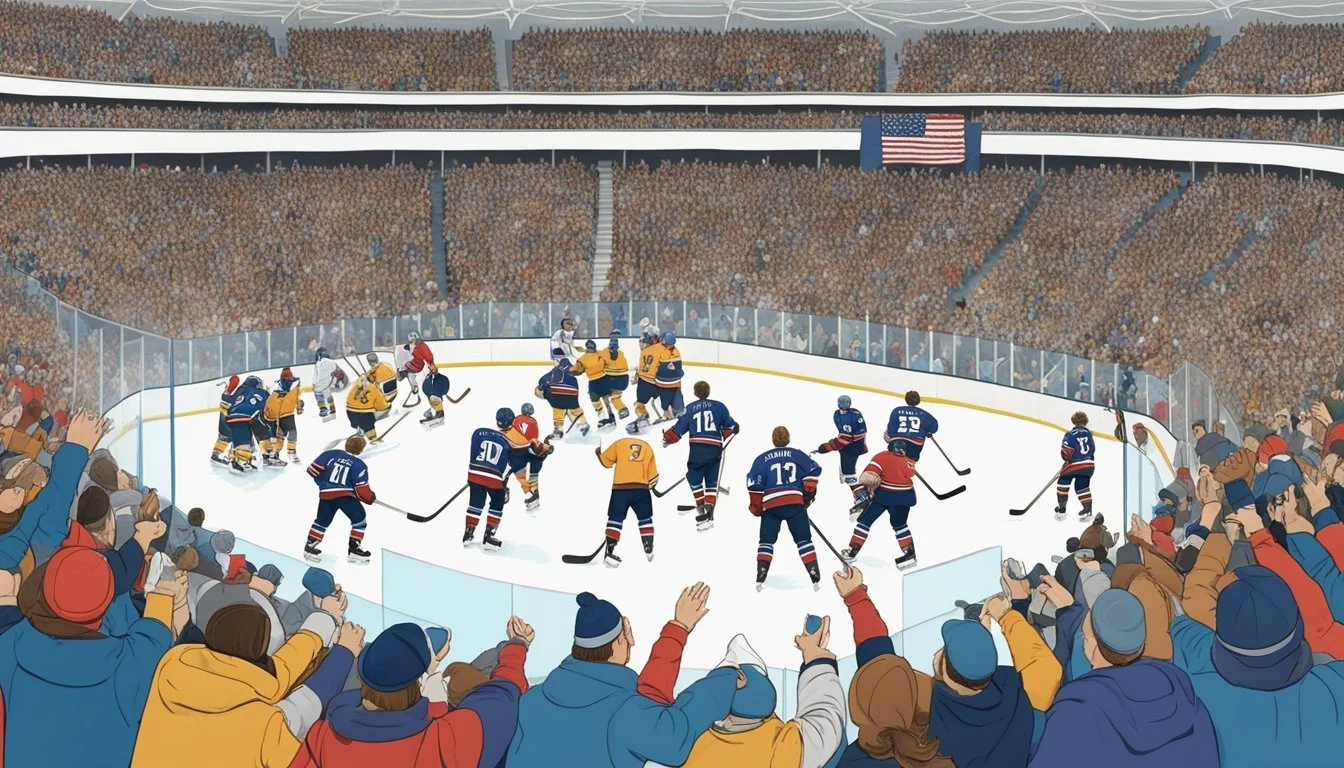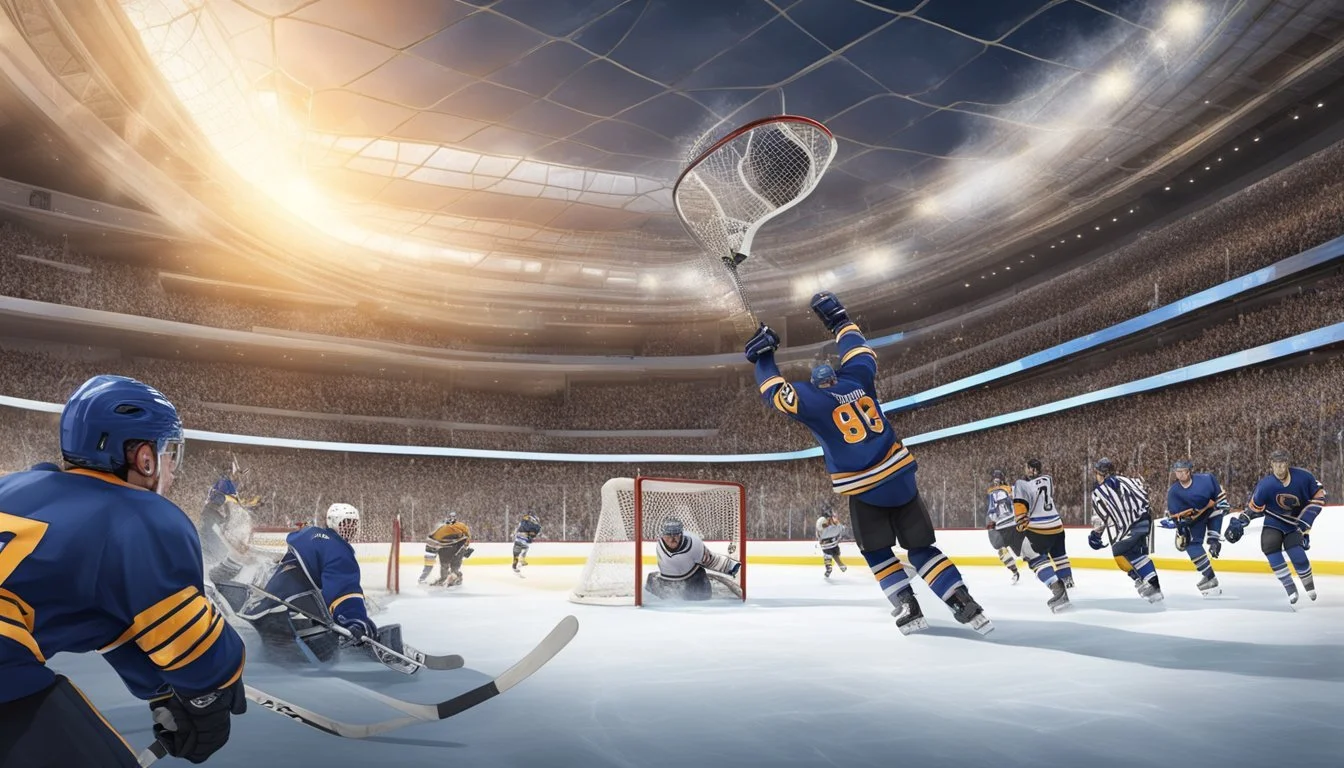The Genuine Miracle: The US Hockey Team's 1980 Olympic Victory
Underdog Triumph Against Soviet Powerhouse
The 1980 Winter Olympics in Lake Placid, New York witnessed an extraordinary moment in sports history. On February 22, a young and inexperienced United States hockey team faced off against the dominant Soviet Union squad. The Soviets had won gold in the previous four Olympics and were heavily favored to win again.
The U.S. team, composed entirely of amateur players, pulled off a stunning 4-3 victory over the Soviet powerhouse in a game that would become known as the "Miracle on Ice". This unexpected triumph captivated the American public and became a symbol of hope during a challenging period for the nation.
The U.S. team's journey to gold medal glory was far from over after their victory against the Soviets. They still needed to defeat Finland in the final game to secure the top spot on the podium. The Americans rose to the occasion once again, winning 4-2 and cementing their place in Olympic lore.
Historical Context
The 1980 Olympic ice hockey tournament unfolded against a backdrop of intense geopolitical rivalry and contrasting athletic systems. Cold War tensions permeated international relations, while stark differences existed between amateur and professional approaches to sport.
Cold War Tensions
The United States and Soviet Union were locked in a bitter ideological struggle in 1980. This rivalry extended beyond politics into cultural and athletic arenas. Olympic competitions became proxy battles for supremacy between the two superpowers. The Soviet ice hockey team had dominated international play for decades, winning gold medals in 1956, 1964, 1968, and 1976. Their success was a source of national pride and propaganda.
American confidence was low following the Iran hostage crisis and economic challenges. A victory over the Soviets in hockey carried symbolic weight far beyond sports. It represented a chance to score a moral victory against a formidable adversary on a global stage.
Amateur Athletics vs. Soviet Professionals
The U.S. Olympic hockey team consisted of amateur college players. Most were in their early 20s with limited international experience. In contrast, the Soviet team featured seasoned professionals who trained year-round. Many had played together for years in a well-funded state-sponsored program.
Soviet players like Vladislav Tretiak and Boris Mikhailov were considered among the world's best. They had access to top coaching, facilities, and competition. The U.S. team, hastily assembled months before the Olympics, faced a significant experience and skill gap.
This disparity in resources and preparation made the eventual outcome even more remarkable. It highlighted fundamental differences between the American and Soviet sports systems of the era.
Forming the Team
The 1980 U.S. Olympic hockey team was carefully assembled through a visionary coach, rigorous player selection, and intense training. This combination laid the foundation for their historic upset victory.
Herb Brooks' Vision
Herb Brooks, the mastermind behind the 1980 U.S. Olympic hockey team, had a clear vision. He sought to create a team that could compete with the dominant Soviet squad. Brooks believed in blending college players with different playing styles to form a cohesive unit.
His strategy focused on speed, conditioning, and adaptability. He wanted players who could think on their feet and adjust to various game situations quickly. Brooks' approach was unconventional for its time, emphasizing a hybrid of North American and European playing styles.
Team Selection
The selection process for the 1980 U.S. Olympic hockey team was thorough and competitive. Over 70 players were invited to a week-long tryout camp in Colorado Springs. Brooks evaluated each player's skills, conditioning, and ability to work within his system.
Key selection criteria included:
Skating ability
Hockey IQ
Physical fitness
Teamwork
Brooks made some surprising choices, favoring players he believed would mesh well together over individual stars. This decision raised eyebrows but ultimately proved crucial to the team's success.
Rigorous Training
Once selected, the team underwent an intense seven-month training program. Brooks' methods were demanding and often controversial. He pushed players to their physical and mental limits, believing this would forge a resilient team spirit.
Training included:
Daily on-ice practices
Grueling off-ice conditioning
Frequent exhibition games against professional and international teams
Brooks' infamous "Herbies" - exhausting skating drills - became a symbol of the team's preparation. These drills improved players' stamina and mental toughness. The rigorous regimen also helped the young team develop the confidence and skill needed to compete at the Olympic level.
Road to the Olympics
The U.S. hockey team's journey to the 1980 Winter Olympics was marked by intensive preparation and challenging encounters. Coach Herb Brooks assembled a young squad of college players and put them through rigorous training to forge a cohesive unit.
Exhibition Games
The team played numerous exhibition games against collegiate and amateur teams across the United States. These matches served as crucial testing grounds for Brooks to evaluate talent and refine strategies.
The players faced tough competition, including games against NHL teams. These contests highlighted areas for improvement and helped Brooks make final roster decisions.
Key exhibition victories boosted the team's confidence, while losses provided valuable lessons. The grueling schedule toughened the young squad mentally and physically.
European Tour
In late 1979, the U.S. team embarked on a European tour to face international competition. They played games in West Germany, Sweden, and other countries, gaining exposure to different playing styles.
The tour proved challenging, with the Americans suffering several defeats against more experienced European clubs. However, these matches were invaluable for team bonding and tactical development.
Brooks used the tour to experiment with line combinations and refine his innovative forechecking system. The players adapted to the larger international ice surfaces, crucial for Olympic success.
Pre-Olympic Challenges
As the Olympics approached, the U.S. team faced formidable opponents in final tune-up games. They played against Soviet club teams and the Canadian Olympic squad, providing a true measure of their progress.
These high-stakes matches revealed both strengths and weaknesses. The Americans showed flashes of potential but also suffered some lopsided defeats, tempering expectations for their Olympic performance.
Brooks used these games to make final adjustments and instill a sense of belief in his players. The team entered the Olympics as underdogs but with a growing sense of unity and purpose.
The Lake Placid Games
The 1980 Winter Olympics in Lake Placid, New York marked a pivotal moment in sports history. From the opening ceremonies to the preliminary rounds and path to the medal round, the Games set the stage for one of the greatest upsets in Olympic history.
Opening the Olympics
The Lake Placid Winter Olympics kicked off on February 13, 1980. The small Adirondack village welcomed athletes from 37 nations. Vice President Walter Mondale officially opened the Games at the Lake Placid Equestrian Stadium.
The Olympic flame arrived after a 1,000-mile journey from Yorktown, Virginia. Figure skater Scott Hamilton carried the torch during the final leg. The cauldron was lit by Dr. Charles Kerr, a member of the 1932 U.S. bobsled team.
Preliminary Rounds
The men's ice hockey tournament began on February 12, featuring 12 teams divided into two groups. The U.S. team, coached by Herb Brooks, consisted mainly of college players.
In their first game, the Americans tied Sweden 2-2. They followed with a convincing 7-3 victory over Czechoslovakia. The U.S. team continued their strong performance, defeating Norway, Romania, and West Germany.
These preliminary round victories boosted the team's confidence and caught the attention of hockey fans worldwide.
Path to the Medal Round
The U.S. team's success in the preliminary rounds secured their spot in the medal round. They faced the Soviet Union, a four-time defending gold medalist, on February 22.
The Soviets were heavily favored, having dominated international hockey for years. They had defeated the U.S. team 10-3 in an exhibition game just days before the Olympics.
Despite the odds, the young American team prepared to face their formidable opponents. The stage was set for what would become known as the "Miracle on Ice."
The Miracle on Ice
The 1980 Winter Olympics in Lake Placid, New York witnessed one of the greatest upsets in sports history. The United States men's ice hockey team, composed of amateur and collegiate players, defeated the Soviet Union, the dominant force in international hockey.
USA vs. USSR Showdown
The matchup between the United States and Soviet Union took place on February 22, 1980. The Soviet team entered as heavy favorites, having won the gold medal in the previous four Olympics. They were considered virtually unbeatable, with a roster full of seasoned professionals.
In contrast, the U.S. team consisted primarily of college players led by coach Herb Brooks. The Americans had lost 10-3 to the Soviets in an exhibition game just days before the Olympics began.
Game Analysis
The game was intense from the start. The Soviets took an early lead, but the Americans fought back. Goals from Mark Johnson and Mike Eruzione in the third period put the U.S. ahead 4-3.
The final 10 minutes saw relentless Soviet attacks. U.S. goalie Jim Craig made several crucial saves. As the clock ticked down, the crowd began counting in unison.
When the final buzzer sounded, the U.S. team had secured their improbable victory. The arena erupted in celebration as players embraced on the ice.
Aftermath of the Victory
The win over the Soviets did not secure the gold medal for the U.S. team. They still needed to defeat Finland in their final game, which they did 4-2.
The "Miracle on Ice" quickly became a symbol of American spirit and determination. It resonated beyond sports, occurring during a time of Cold War tensions between the U.S. and Soviet Union.
The victory has been immortalized in popular culture through books, documentaries, and films. It remains one of the most iconic moments in Olympic history, inspiring generations of athletes and fans.
Securing the Gold Medal
The US hockey team's journey to Olympic glory culminated in a tense final against Finland. Their historic victory over the Soviet Union set the stage for a dramatic gold medal showdown.
The Finland Game
The US faced Finland on February 24, 1980, in Lake Placid, New York. Despite their previous triumph, the Americans found themselves trailing 2-1 after two periods. Coach Herb Brooks delivered a passionate speech during the intermission, urging his team to dig deep.
Inspired by their coach's words, the US mounted a remarkable comeback in the third period. Phil Verchota tied the game early on. Rob McClanahan then scored the go-ahead goal, putting the US in front.
Winning the Gold
With the lead secured, the US team tightened their defense. Mark Johnson added an insurance goal late in the game. As the final seconds ticked away, the crowd began to countdown.
When the buzzer sounded, the US had won 4-2. Players threw their sticks and gloves into the air in celebration. Team captain Mike Eruzione led his teammates to the top of the podium to receive their gold medals.
This victory marked only the second time in history that the United States had won Olympic gold in ice hockey. The team's improbable run captured the imagination of the American public and became known as the "Miracle on Ice."
Impact and Legacy
The "Miracle on Ice" victory left an indelible mark on American sports and culture. It transcended hockey, becoming a symbol of national pride and determination.
Cultural Significance
The 1980 U.S. hockey team's triumph resonated far beyond the ice rink. It became a powerful patriotic moment during the Cold War era. The victory boosted American morale and united the country in celebration.
Sports Illustrated named it the top sports moment of the 20th century. The game has been immortalized in books, documentaries, and the 2004 film "Miracle."
The phrase "Do you believe in miracles?" uttered by broadcaster Al Michaels, became iconic. It's now synonymous with unexpected triumphs in sports and life.
Inspirational Aftermath
The 1980 team's success inspired a new generation of American hockey players. NHL participation by U.S.-born players increased significantly in subsequent years.
Youth hockey enrollment saw a substantial boost across the country. Many future NHL stars cited the "Miracle on Ice" as their motivation to pursue the sport.
The victory instilled a belief that U.S. teams could compete at the highest international levels. This confidence carried over to other sports, enhancing America's overall Olympic performance.
Continuing Legacy
The "Miracle on Ice" remains a touchstone in American sports culture. It's frequently referenced during international competitions, especially the Olympics.
The team's achievements are commemorated in the U.S. Hockey Hall of Fame. Several players went on to successful NHL careers, furthering the impact of their Olympic success.
The story continues to inspire new generations. It's taught in schools as an example of teamwork, perseverance, and the power of believing in oneself against overwhelming odds.
Key Figures
The 1980 U.S. Olympic hockey team's victory was made possible by several key individuals who played crucial roles. Their leadership, skill, and dedication were instrumental in achieving the historic upset.
Coach Herb Brooks
Herb Brooks led the U.S. team to their improbable victory. His innovative coaching methods and rigorous training regimen pushed the young players to their limits. Brooks emphasized team unity and conditioning, focusing on a European-style of play to counter the Soviets' strengths.
He hand-picked his roster, prioritizing speed and teamwork over individual talent. Brooks' motivational tactics, though sometimes controversial, instilled a fierce determination in his players.
His famous pre-game speech before facing the Soviets became legendary: "You were born to be a player. You were meant to be here. This moment is yours."
Prominent Players
Mike Eruzione captained the team and scored the winning goal against the Soviets. His leadership on and off the ice was crucial to the team's success.
Jim Craig's stellar goaltending kept the U.S. in games against superior opponents. He made 36 saves in the match against the Soviet Union.
Mark Johnson led the team in scoring throughout the tournament. His two goals in the "Miracle on Ice" game were pivotal.
Other standout players included defenseman Ken Morrow and forwards Dave Silk and Mark Pavelich. Their contributions in key moments helped secure victories against formidable opponents.
Support Staff
Craig Patrick served as Brooks' assistant coach, helping implement strategies and manage player relationships. His NHL experience provided valuable insights to the young team.
Team doctor George Nagobads attended to players' health and injuries. His expertise ensured the team remained in peak physical condition throughout the grueling tournament.
Equipment manager Tom Blais kept the players' gear in top shape, crucial for maintaining performance in the fast-paced games.
The support staff's behind-the-scenes work was essential in creating an environment where the players could focus solely on their on-ice performance.
In Popular Culture
The 1980 US Olympic hockey victory has left an indelible mark on American culture. This historic event has been immortalized in various forms of media and continues to resonate with the public decades later.
Film and Television
The most notable film adaptation is the 2004 Disney movie "Miracle," starring Kurt Russell as Coach Herb Brooks. This critically acclaimed film recreates the team's journey and the iconic game against the Soviet Union. Several documentaries have also explored the event, including "Do You Believe in Miracles? The Story of the 1980 U.S. Hockey Team" (2001) and "Of Miracles and Men" (2015), which offers the Soviet perspective.
Television shows have frequently referenced the "Miracle on Ice." Popular series like "The Simpsons" and "Family Guy" have included nods to the historic game. Sports networks regularly feature retrospectives and anniversary specials about the event, especially during Olympic years.
Books and Publications
Numerous books have been written about the 1980 US hockey team's victory. "The Boys of Winter" by Wayne Coffey (2005) provides an in-depth look at the players and the game itself. Team captain Mike Eruzione's memoir "The Making of a Miracle" (2020) offers a firsthand account of the experience.
Sports Illustrated has published several commemorative issues dedicated to the "Miracle on Ice." The event is frequently included in lists of greatest sports moments and has been the subject of countless articles and opinion pieces in major publications.
Public Perception
The "Miracle on Ice" remains a potent symbol of American triumph against overwhelming odds. It is often invoked in speeches and public discourse as an example of national pride and perseverance.
Many of the players from the 1980 team have become sought-after motivational speakers. The phrase "Do you believe in miracles?" uttered by announcer Al Michaels during the game's final seconds, has become a cultural touchstone.
The team's victory continues to inspire new generations. Youth hockey programs often reference the 1980 team as a source of motivation. The Lake Placid Olympic Center, where the game took place, has become a pilgrimage site for hockey fans and history enthusiasts alike.





